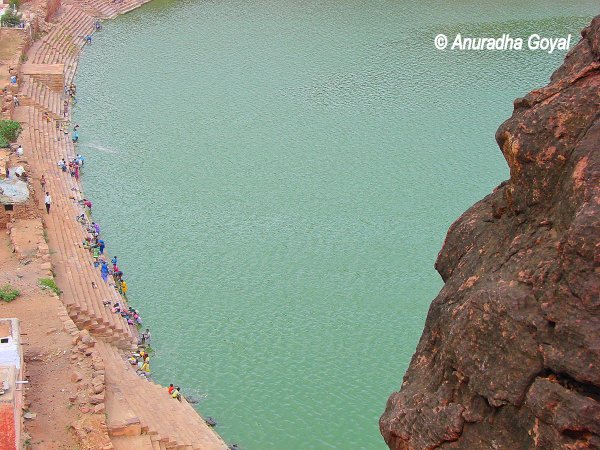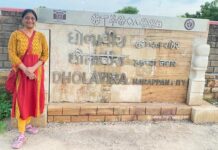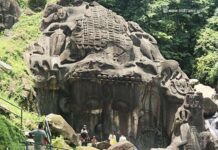
I and a few fellow couch surfers have been planning this trip for almost a year now. But like books I read when their time comes, the time for this trip was now and probably with people whom I was yet to meet. Badami is about 500 km northwest of Bangalore in Bijapur district. It was the capital of Chalukyas and would have been at its best in the 6th century. All the three places Badami, Aihole, and Pattadakal tell you the stories through its sculptures and temples that have lived through the centuries.
Badami, Aihole, Pattadakal – Tourist Places in Karnataka

Badami Places to visit
Agastya Teertha Lake
The attractions of this place are more or less clustered around the Agastya Teertha Lake. A huge lake which was once supposed to have medicinal powers that could cure skin diseases. Though, now they say it can give you some diseases if you step in.
Caves Temples
As you go from the main road, on the right-hand side of the lake are Badami caves temples. Chiseled out of the single huge monolithic rock. Reddish brown in color, resembling the color of almonds and hence giving the place its name: Badami. There are 4 caves, first three are Hindu caves and the fourth one is a Jain cave. The first cave is dedicated to Shiva. Second and third are dedicated to Vishnu and the fourth one to Jain Thirthankaras. There is also an unfinished cave in between the second and third cave which was probably being carved by Buddhists.
Shiva Carvings
There are many carvings on the walls of all the caves. Which give you a peep into the religious and at times social inclinations of the society in times of Chalukyas. There are unusual poses of Shiva like the one with 18 arms to depict the 81 different dance postures. And there are various instances of Ardhanarishvara with Shiva and Parvati depicted in a single representation. There is a similar depiction of Harihara, which is half Shiva and half Vishnu. What is interesting is that besides religious symbols, Gods and Goddesses and stories from the mythology there are quite a few puzzles that have been carved. Some of them are still unsolved and some of them have the solutions etched right beside them.
Badami Fort
There is also a fort that was built by Tipu. You can see the wall of the fort and the stairs leading to the fort, but it is closed to the public as of now.
On the other side of the lake is the fort that has been built around the 52 natural rocks that lie close to each other separated by narrow ridges. The place seems to be used by film production units a lot. There are various temples on the way to the top of this fort. At the top, you can get a good view of the town and its surroundings. Especially when you stand on the watchtower.
Museum
At the watchtower on the hill is the ASI museum where some of the excavated sculptures are kept. I wish there was better documentation available at the museum so that it could have been more informative for people.
Bhoothnath Temple
Across the lake is the Bhootnath temple, which gives a very picturesque look through the lake. As you reach the temple, you would find that it is actually a small complex containing many temples. The main temple is a Shiva temple. There is also a Vishnu temple. Then there is a huge rock which was probably used by the students or trainee artists to learn the art of carving the stone. You can see the unfinished pieces of work and also the probable learning stages. There is a path from here that leads to Mahakoota.
The lake itself is used to wash clothes by the locals now. The town almost lives in between all the old structures. From a lot of points, you can see the past and the present co-existing. To walk from one side of the lake to another you have to go through the current day labyrinth of the town. The tour guides will give you good stories about the place.
Some modern-day sculptures have been put on one side of the lake very recently. Which is supposed to depict the life as it used to be, but really takes away the natural beauty of the place? They stand nowhere close to what has left in the place centuries ago. And almost look like an eyesore. Take a picture of the lake from any side and you will get a beautiful picture with a good backdrop. Be aware of monkeys that inhabit the place and jump on you for any food that you may be carrying in your hands.

Aihole – Places to visit
Aihole is a town about 40 km’s away, and you can take an auto or a bus to reach there. There are 3 main complexes in Aihole that you can see. Though there are supposed to be more than 100 temples in this town. Now this place was supposed to be the training ground for all the artists who would go and write the stories in stone for the future. The temples here were probably never worshiped. They were used only for the training ground purpose for the learning artists.
Temples
The most notable temple in the complex is Durga temple. Which is not dedicated to Goddess Durga, but refers to the fort, as Durga is also the Hindi word for the fort. The temple will invariably remind you of Parliament building in New Delhi. You would wonder if this was the inspiration for that. Though the guide would tell you that there is no documented evidence for the same. Then there is Ladkhan temple, named after a Muslim, which does not actually resemble any temple that you would have seen. It looks like a colonial villa with a wooden roof, but this wooden look has been carved in stone. There are temples at various levels from the ground. The complex also houses a museum, where interestingly you can buy books by ASI.
Pattadakal Places to visit
Pattadakal is the world heritage site and is a huge complex with multiple temples. This place was primarily used for the coronation of the kings is what the guide would tell you. But as the complex exists today; it is difficult to see how they did it, as all the temples are pretty close to each other. It was definitely an experimental ground for temple architecture, especially the upper stupas or the Gumbaj of the temple. There are a few temples in north Indian style like the ones you find in Orissa. And a few in south India style like ones that Pallavas built mostly in Tamil Nadu.
Then you see a fusion of both the style and that is the style that Chalukyas created. And it is their contribution to the world of temple architecture. Since the Chalukyan kingdom had its spread from north to south, it could have been a need to evolve a style that combined the two ends of the kingdom. They could have been inborn experimenters to mix and match styles to create a new one. There is only one temple, which is a practicing temple, the Virupaksha temple. All others are Khandit or destroyed and hence are not worshiped anymore. This was the last spot we visited, so we found a lot of repetition of sculptures on the walls as well as the guide stories.
This complex is on the side of the river Malaprabha, and you can see it from the Papanatha temple. This complex is a visual treat, and your camera would just love it.
Mahakoota
There are some other structures scattered around in the region and if you have ample time, the signboards on the road would guide you to them. We visited one such structure called Mahakoota, which is hot water spring. With a tank built around it, surrounded by Shivalingas and even the one below in the tank. Sage Agastya is supposed to have lived here. This place is probably the most untouched place of all the places we visited. And hence carries that air of old soul living as it is. Then there is Banashankari temple and a few other temples.
Every guide in all three places will tie up all these places by saying that Aihole is the primary school with fundamentals of carvings and temple design. Badami is the high school, Pattadakal a college and temples in Belur and Halebidu a university of the art form. By the end, you would be tempted to ask the guides, if they all studied in the same school to utter the same words.
All these three places have been the capital of Chalukyas. At various points in time during their reign. Guides would also tell you that till about 60-70 years back, all these monuments were actually used by people to live. So there were villages that lived completely inside these structures. They would show you the signs of their living, by way of a lot of board games carved on the floors, small grooves in the floor that was used as grinders for the kitchen.
Tourist Amenities
A visit to these heritage places would leave you with a feeling of having visited a piece of history. But the current day infrastructure will leave much to be wanted. There is no good connectivity from Hubli or to move around within these places. At least on weekends, these destinations attract a lot of visitors. But there are hardly any amenities. For example, at Pattadakal, you can spend a complete day but there is nothing that you would get to eat in or around the complex. The roads are actually not bad, but there is hardly any public transport to travel between these places.
But nonetheless, if you live in India these are not the challenges that stop you from exploring. Go ahead and enjoy this marvel from the past.
Recommend you to read the following travel blog on Tourist Places in Karnataka.
Gol Gumbaz – A Reverberating Dome
Unexplored Karnataka – Keladi & Ikkeri














Hi Anuradha,
I am your student from creative workshop. Your Blogspot is indeed interesting. How do you get time to do all these. Read books, Write Blogs and travel..Amazing.
Regards
Krishna
Wow! I have heard so much about you and this is the first post I am reading! I feel like I am talking to a friend over phone and she is suggesting me places to visit! How helpful 🙂 Yes, the places here are a visual treat, though I think I have missed out on some and must plan a re-visit soon!
I just started blogging a month ago. Thank you for being my inspiration!
Rommanne, you should visit IndiTales more often :-).
Wish you all the best beginning the exciting travel blogging journey.